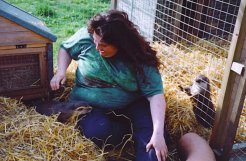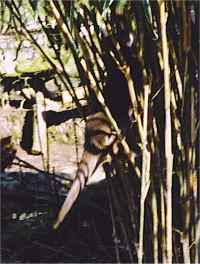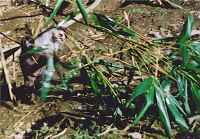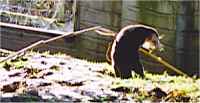 |
Last Update:
Thursday November 22, 2018
|
| [Home] |
|
Volume 22 Issue 1 Pages 1 - 44 (April 2005) Citation: Wright, L. (2005) Interesting Cooperative Bedding Gathering Behaviour In Captive Asian Small-Clawed Otters (Amblonyx cinerea). IUCN Otter Spec. Group Bull. 18(1): 25 - 28 Interesting Cooperative Bedding Gathering Behaviour In Captive Asian Small-Clawed Otters (Amblonyx cinerea) Lesley Wright CCLRC Rutherford Appleton Laboratory, R1, 1.58, Chilton, Didcot, Oxon, OX11 8SR. Email: lc.wright@yahoo.co.uk
On 20th March 2005, I visited Exmoor Zoo in Devon, UK, to do behavioural observations on the Asian Small-Clawed Otters for the KASBAH project (WRIGHT, 2003). The otters there display an interesting method of gathering bedding, which might be of interest to other otter keepers. At this time, the otter group consisted of a male, a female and their two six-month old female cubs. The pen is heavily vegetated, but the otters selectively prefer bamboo leaves for bedding, and have stripped the lower parts of the bamboo canes for this purpose. Over this winter, they developed a technique for gaining access to the upper parts of the bamboo. First, the alpha female climbs up a bamboo cane to approximately four feet above the ground. There she appears to test the flexibility of individual canes by rocking on them using her front paws whilst balancing on the original cane with her hind feet and tail (see Figure 1). She then climbs onto the chosen cane, holding on with paws and teeth, and begins to use her body weight to sway the cane too and fro, gradually edging out on the cane as it begins to bend. During this process, the rest of the otter family gathers under the bamboo and watch.
As the cane bends, she lets go with her back paws and hangs on the cane, so that her weight bows it towards the ground. The rest of the family gather under where the leaves of the cane are descending, reach up and grab the leaves and pull it down. The whole family then rips leaves off the bamboo and takes them to the holt for bedding (see Figure 2). During the three periods of observation of this behaviour, the cane was never left to spring back.
When all the leaves have been removed, the rest of the otter family moves off to groom or forage, but the alpha-female then shreds as much as she can of the cane itself (see Figure 3) - on one occasion severing it and dragging it to the holt.
According to the keepers, the otters go through this routine several times a week, and on some days, several times a day; I observed three such events during a single day’s observation. This behaviour seems to show a reasonably high degree of planning and cooperation to achieve the desired end. It also demonstrates that pen vegetation can provide good enrichment if the animals are allowed to make use of it for their own ends. ACKNOWLEDGEMENTS - Thanks to Mr Danny Reynolds and Mr Steve Eddy at Exmoor Zoological Park for allowing me to work there, and providing information about the history of this behaviour. REFERENCES Wright, L.C. 2003. Assessing the Welfare of Captive Asian Small-Clawed Otters (Amblonyx cinereus): can Inductive Methods play a Part? IUCN Otter Spec. Group Bull. 20 (1): 35-41. Résumé : Intéressant Comportement d’Entraide dans la Collecte de Matériau pour leur Litière, Observé chez des Loutres Cendrées (Amblonyx cinerea) en Captivité Resumen: Comportamiento Cooperativo Observado en Madriguera en la Nutria de Río de Uñas Pequeñas Asiática (Amblonyx cinerea) Viviendo en Captividad |
| [Copyright © 2006 - 2050 IUCN/SSC OSG] | [Home] | [Contact Us] |



